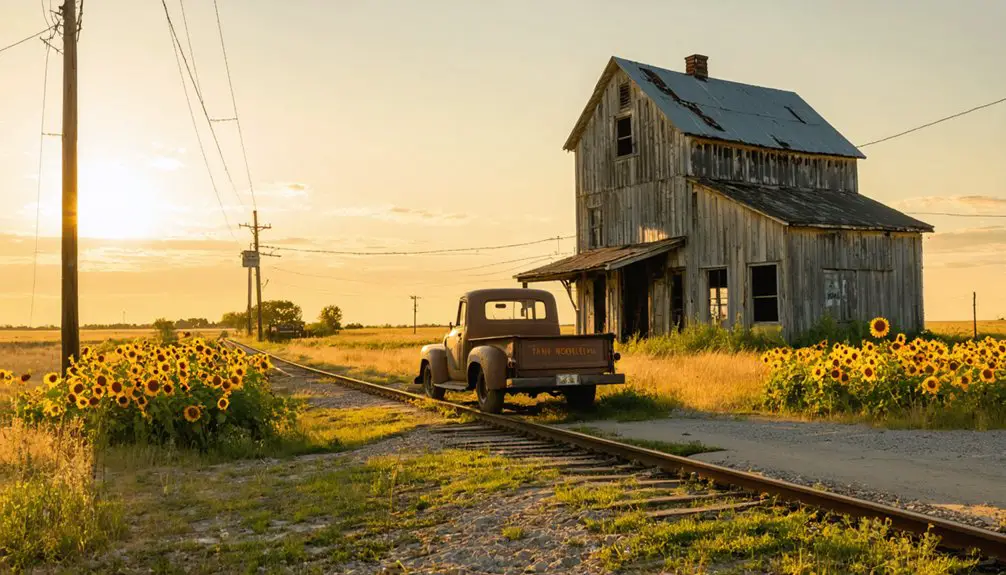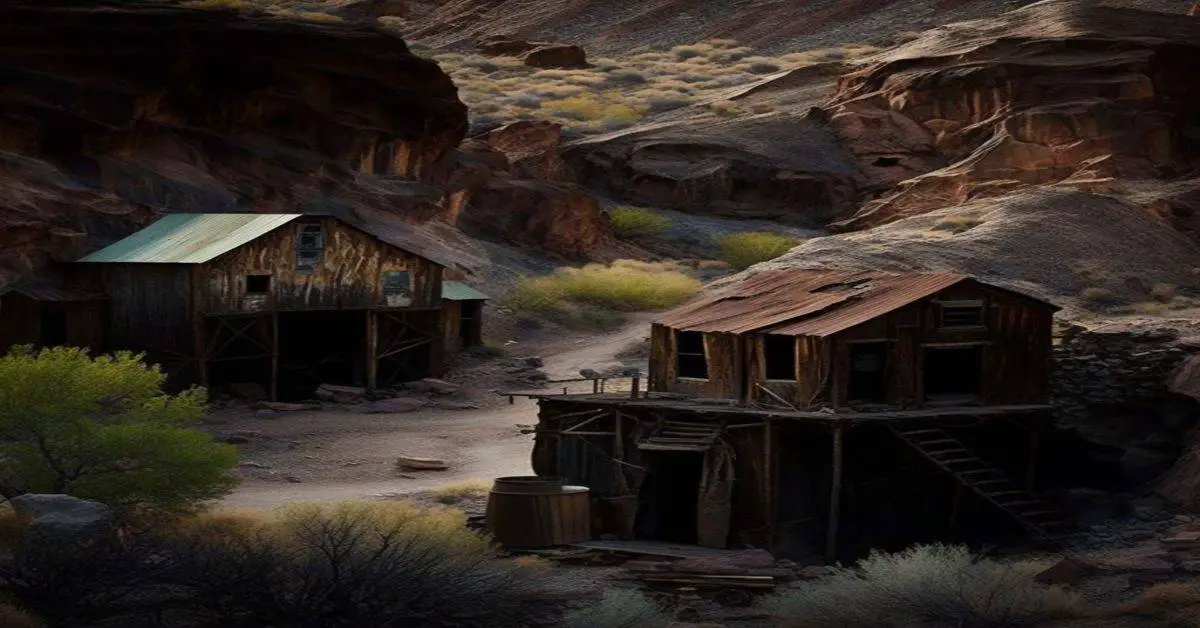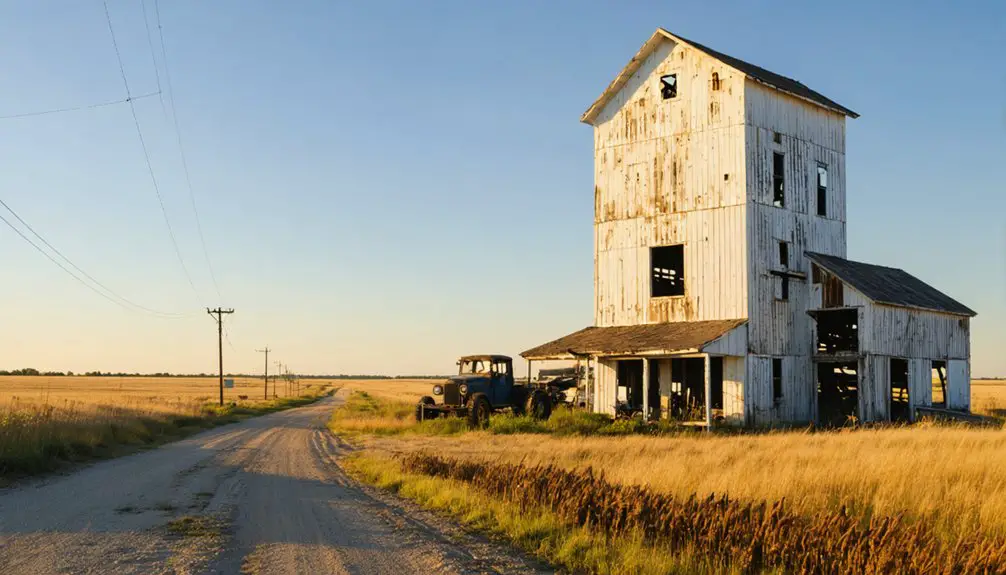You’ll find Verendrye’s abandoned remains in rural North Dakota, where a weathered schoolhouse still bears its original name “Falsen” from 1913. The town, renamed in 1925 to honor explorer Pierre La Vérendrye, thrived briefly with 75 residents before succumbing to agricultural challenges and rural exodus by 1970. Today, prairie grasses reclaim the ghost town’s footprint, while the solitary schoolhouse stands as a sentinel to North Dakota’s pioneer past. Its crumbling walls hold countless stories of frontier dreams and decline.
Key Takeaways
- Verendrye, originally named Falsen, was established in 1913 and became a ghost town by 1970 when its last residents departed.
- The abandoned Falsen Schoolhouse remains the only standing structure, serving as a historic reminder of the former community.
- The town was renamed Verendrye in 1925 to honor explorer Pierre La Vérendrye’s 1738 expedition through North Dakota.
- Agricultural mechanization, economic challenges, and rural exodus contributed to the community’s decline and eventual abandonment.
- Native prairie grasses and wildlife now reclaim the ghost town’s former streets and infrastructure, with limited remnants visible.
A Town’s Two Names: From Falsen to Verendrye
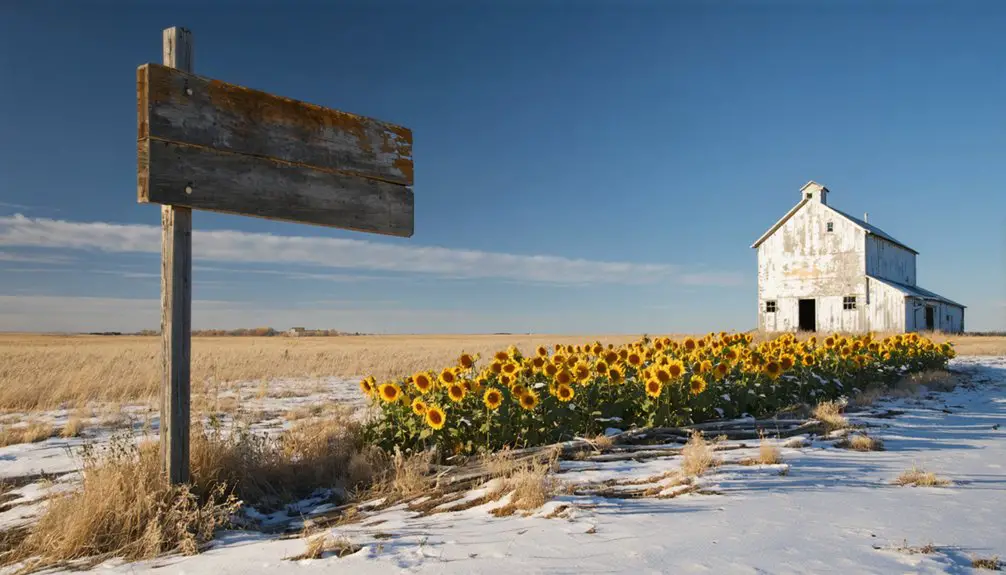
The small settlement of Falsen emerged in 1913 when its first post office opened under postmaster Oliver Molhowe. By 1925, this North Dakota town had grown to about 75 residents, reflecting the steady development of rural communities in the region.
The town’s original name drew from the area’s strong Norwegian and Danish heritage.
Reflecting its Nordic roots, the settlement embodied the cultural footprint of Norwegian and Danish immigrants who shaped early North Dakota.
You’ll find the town naming took an interesting turn when local resident Budd advocated for change, suggesting the name “Verendrye” to honor French Canadian explorer Pierre La Vérendrye.
After an unsuccessful attempt to name it “Thompson” – already claimed by another North Dakota town – the post office officially adopted Verendrye.
This new name carried historical significance, commemorating La Vérendrye’s pioneering 1738 expedition through the territory, during which he became one of the first Europeans to explore North Dakota.
The Last Standing Schoolhouse
Standing as a solitary sentinel of Verendrye’s past, only the weathered facade of Falsen School remains on posted private land today.
This crumbling structure marks the last visible remnant of a once-thriving community that called this place home until 1970.
Originally established as Falsen, the town underwent a name change in 1925 to become Verendrye.
The schoolhouse’s significance extends beyond its educational legacy.
As the town’s former social and learning center, it witnessed the rise and fall of pioneer families who settled here in the early 1900s.
You’ll find its name still etched on the facade, though the building’s interior and walls have long since collapsed.
While you can’t approach closely due to private property restrictions, you can spot the ruins near the David Thompson memorial, where they serve as a poignant reminder of North Dakota’s vanishing rural heritage.
Pioneer Explorer Heritage

While many pioneer settlements dot North Dakota’s landscape, Verendrye’s historical significance stems from its namesake, Pierre La Vérendrye, who led groundbreaking expeditions through this region in the late 1730s.
You’ll find his explorer influence throughout the area, as he established essential trading posts and forged relationships with Mandan villages along the Missouri River.
La Vérendrye’s legacy lives on in the region’s heritage preservation efforts. He preceded Lewis and Clark by nearly 60 years, marking the first European presence in North Dakota.
As North Dakota’s first European explorer, La Vérendrye blazed trails six decades before Lewis and Clark’s famous expedition.
His sons later ventured even further west, possibly reaching the Rocky Mountains in 1742. The network of forts they established strengthened French claims in North America and opened new opportunities for fur trading, forever changing the economic landscape of the northern Plains.
Life and Death of a Prairie Settlement
You’ll find the poignant story of Verendrye in its once-hopeful settlement patterns, where pioneer families carved out homesteads and built a schoolhouse that still watches over the empty prairie today.
Though the town started with promise in 1912, the harsh realities of Great Plains farming, economic hardship, and rural flight gradually emptied its streets until the last residents departed by 1970. Similar to sites like Sherbrooke, its abandoned structures tell the tale of zero residents remaining.
The resilient schoolhouse now stands alone among overgrown foundations and fading road outlines, while wild grasses reclaim the land where a community’s dreams once took root. Modern visitors exploring these grounds must respect the private property signs that protect what remains of this historic settlement.
Pioneer Dreams Fade Away
When pioneers first established Verendrye in 1912 under the name Falsen, they envisioned a thriving agricultural community on North Dakota’s vast prairie. Their pioneer aspirations centered around the schoolhouse, which became the heart of local life and social activities. You can still see “Falsen” etched on its weathered facade today.
The Mouse River floods devastated the area in the 1940s, further challenging the struggling community. Yet agricultural hardships, harsh climate, and isolation gradually eroded their dreams. By 1925, they’d renamed the settlement Verendrye, honoring the French explorer who’d traversed these lands in 1738.
But the promise of prosperity continued to slip away. As younger generations sought opportunities in urban areas, the population dwindled. Businesses closed, services vanished, and by 1970, the last resident had departed.
Today, only the schoolhouse stands as a monument to those faded dreams.
Schoolhouse Stands Sentinel Still
Standing resolute against the prairie winds, the Verendrye schoolhouse remains a tribute to North Dakota’s pioneer education.
You’ll find its wood-frame construction and bell tower typical of rural schools that once dotted the landscape every few miles, allowing farm children to walk or ride horses to class.
The schoolhouse memories echo through its restored walls – from the fuel oil heating that was advanced for its time to the large basement where students took shelter during harsh winters.
While vandals once shot out its windows and neglect threatened its legacy, community volunteers wouldn’t let this piece of educational heritage fade away.
Today, you can experience firsthand how pioneer children learned, as the relocated building serves as a living museum connecting modern generations to their prairie roots.
Nature Reclaims Prairie Past
As nature gradually reclaims the abandoned townsite of Verendrye, native prairie grasses and bushes have erased nearly all traces of human settlement.
You’ll find the former streets and building foundations nearly invisible now, swallowed by decades of vegetation growth since the last resident departed in 1970.
The ecological restoration has been thorough and swift.
Wildlife has returned to these grounds where homes and businesses once stood, creating a new balance in the absence of human activity.
While community memory fades like the physical remnants of the town, the land itself tells a story of resilience.
What was once a bustling prairie settlement has seamlessly blended back into the surrounding ecosystem, leaving only whispers of its former existence in the rustling grasses.
Ghost Town Tourism and Visitors
Today’s visitors to Verendrye ghost town seek more than just empty buildings – they’re drawn to a powerful connection with North Dakota’s vanished rural heritage.
Like many heritage tourism sites, Verendrye offers visitors a chance to experience preserved remnants of American history firsthand.
You’ll find fellow explorers photographing weathered grain elevators, abandoned churches, and forgotten railroad depots that tell stories of prairie life.
Many visitors come to study how the development of Interstate Highway System contributed to the isolation and eventual abandonment of communities like Verendrye.
Ghost town exploration peaks during summer months when road conditions are safest.
Summer brings the best conditions for ghost town visits, with dry roads making these remote destinations more accessible.
You’ll need to navigate limited signage and rough access roads, as interstate highways now bypass these historic sites.
While tourism numbers have declined since late 2024 due to economic uncertainties, you’ll still encounter photographers, historians, and curious travelers drawn to Verendrye’s quiet isolation.
The site offers unique opportunities for rural tourism, letting you walk freely through a landscape where nature and history intersect.
Natural Reclamation of a Lost Community

You’ll find Verendrye’s remnants slowly disappearing beneath waves of native prairie grasses and persistent vegetation that have reclaimed the town’s streets and yards over decades.
The last schoolhouse still stands as a weathered sentinel, though its wooden frame battles against North Dakota’s harsh elements while wildlife makes homes in its deteriorating walls.
Nature’s persistent advance transforms the ghost town through each season, as windblown soil fills old foundations, trees push through abandoned structures, and local fauna establish new movement corridors across the former settlement.
Wilderness Claims Streets
Since the last resident departed Verendrye in 1970, native vegetation has steadily reclaimed the town’s street grid and infrastructure.
You’ll find wilderness encroachment has transformed once-bustling pathways into barely visible outlines, with street obscurity becoming more pronounced each passing season.
Nature’s persistent advance has left only the historic schoolhouse standing, its “Falsen” nameplate a reminder of the town’s original identity.
- Wild grasses and trees freely grow through deteriorating road surfaces, erasing evidence of human settlement
- Aerial views might reveal faint traces of the street layout during certain seasons
- The David Thompson memorial statue stands amid the untamed landscape, marking where civilization once thrived
This pattern of natural reclamation mirrors the fate of many North Dakota ghost towns, where the wilderness now rules unchallenged.
Nature’s Return to Civilization
The natural world’s steady reclamation of Verendrye offers a compelling study in ecological succession.
You’ll find native grasses and shrubs breaking through abandoned streets, while urban wildlife claims the spaces where homes once stood. Since 1970, when the last resident departed, nature’s restoration process has transformed the town into a vibrant ecosystem.
Pioneer species colonized first, followed by more complex plant communities.
Today, you’ll spot birds nesting in the weathered schoolhouse – the town’s sole remaining structure – while small mammals dart through the understory.
What were once manicured lawns now support thriving populations of native flora.
This ecological restoration showcases nature’s resilience, as each passing season further blurs the boundary between civilization and wilderness, letting natural processes heal the human-altered landscape.
Historical Markers and Memorials
Commemorating Pierre Gaultier de Varennes et de La Vérendrye’s expeditions, a prominent monument stands in Fort Pierre, South Dakota, where it was erected in 1933.
A historic monument in Fort Pierre honors La Vérendrye’s journeys, standing since 1933 as a testament to French exploration.
This site’s historical significance earned it a spot on the National Register of Historic Places in 1974 and National Historic Landmark status in 1991.
You’ll find the original lead plate, discovered in 1913, preserved at the South Dakota Cultural Heritage Center in Pierre, representing tangible evidence of French exploration.
Like many abandoned North Dakota towns, Verendrye sits isolated in the rural countryside with only a few crumbling structures remaining.
- Visit the Menoken Indian Village Site near Bismarck to explore prehistoric indigenous life
- Discover Double Ditch’s fortified Mandan earth lodge villages showcasing native cultures
- Experience the cultural impact through interpretive centers featuring French trade artifacts
Throughout North Dakota, historical markers trace La Vérendrye’s 1738 route along the Missouri River bottomlands, offering insights into the region’s exploration heritage.
Rural Exodus and Abandonment
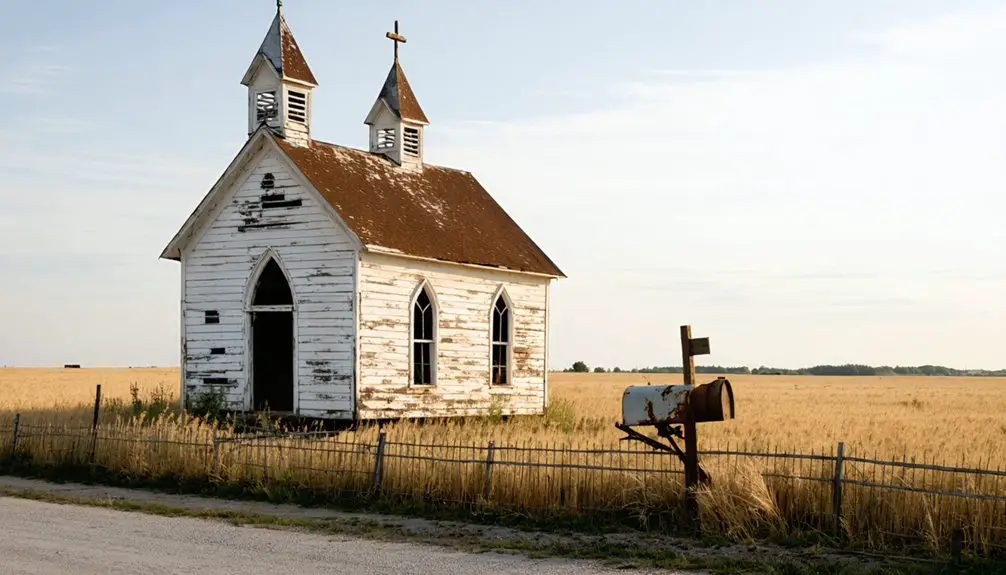
During the mid-twentieth century, Verendrye’s population steadily declined as agricultural mechanization reduced farm labor needs and limited economic opportunities drove younger residents toward urban centers.
This rural migration accelerated as local businesses closed, tax revenues dropped, and public services deteriorated. Without industrial development or resource extraction to sustain the economy, you’d have witnessed the systematic community decline through shuttered storefronts and empty homes.
The harsh North Dakota winters and geographic isolation made life increasingly difficult for those who remained.
By 1970, you’d have seen the final traces of liveliness fade as the schoolhouse became the last standing reminder of Verendrye’s once-vibrant community.
The surrounding landscape slowly reclaimed abandoned properties while aging residents relocated, marking the end of this rural settlement’s story.
Photographic Documentation Through Time
As photographers documented Verendrye’s transformation from settlement to ghost town, they captured distinct phases of the community’s decline through diverse visual records.
The photographic evolution begins with early 1900s images of the Falsen schoolhouse and bustling streetscapes, progressing to stark depictions of abandonment by 1970.
From vibrant schoolyards to empty streets, Verendrye’s photos chronicle its slow fade into prairie silence.
Today’s visual storytelling relies heavily on drone photography and comparative techniques to showcase the town’s sole remaining structure amid the reclaiming prairie.
- Early photos and postcards preserve glimpses of daily life, including the David Thompson memorial statue and original infrastructure.
- Time-lapse and infrared photography techniques reveal the gradual decay of buildings and signage.
- Modern aerial documentation maps forgotten road patterns while capturing the desolate atmosphere typical of North Dakota ghost towns.
Legacy in North Dakota’s Settlement History
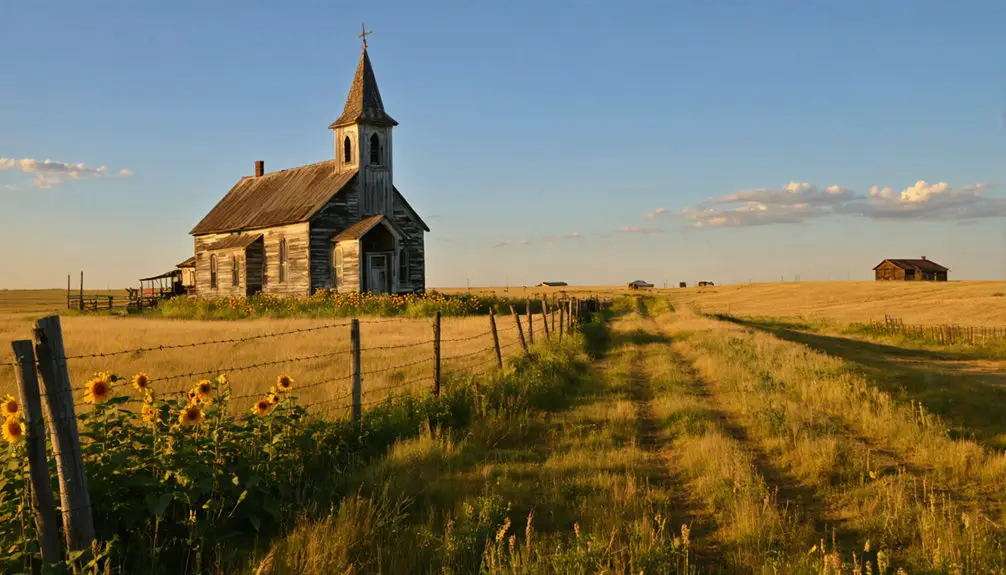
Pierre Gaultier de la Verendrye’s 1738 expedition into North Dakota marked a pivotal shift in the region’s settlement trajectory.
As the first European explorer to document this frontier, his impact resonated through generations of settlers who followed his mapped routes and trading patterns.
You’ll find Verendrye’s legacy woven into North Dakota’s early development through the fur trading posts and settlements that emerged along his documented paths.
His detailed accounts of Mandan and Hidatsa villages helped shape settlement patterns, while his relationships with indigenous peoples established essential trade networks.
The discovery of his lead tablet near the Missouri River in 1913 stands as tangible proof of his far-reaching influence.
His expeditions didn’t just chart new territories – they laid the foundation for European settlement across the Northern Plains.
Frequently Asked Questions
Are There Any Reported Ghost Sightings or Paranormal Activity at Verendrye?
You won’t find documented ghost stories or paranormal investigations at this location. Research and local records don’t show any verified supernatural activity in the remaining schoolhouse or abandoned town site.
What Happened to the Other Buildings That Once Stood in Town?
You’ll find most building remnants have collapsed or been demolished over time, with no historical preservation efforts saving them. They’ve deteriorated beyond recognition, leaving only outlines where structures once stood.
Can Visitors Legally Explore the Schoolhouse Interior Today?
Like a fortress with locked gates, you can’t legally enter the schoolhouse interior today. Current visitor regulations prohibit access since it’s on private property and explicitly posted against trespassing.
Were There Any Notable Crimes or Tragic Events in Verendrye’s History?
You won’t find any documented unsolved mysteries or historical tragedies here. Research shows the town’s history was remarkably quiet, with its abandonment by 1970 stemming from typical rural decline.
What Was the Town’s Peak Population Before Its Decline Began?
While some speculate higher numbers, you’ll find the most reliable historical records show a peak of 100 residents in 1938, before population decline began shifting this once-bustling railroad stop toward abandonment.
References
- https://www.onlyinyourstate.com/experiences/north-dakota/ghost-towns-nd
- https://www.funtrivia.com/askft/Question151041.html
- https://www.youtube.com/watch?v=eBfraH7yoGw
- https://www.youtube.com/watch?v=0n3LvrSDRLU
- https://ghostsofnorthdakota892857007.wordpress.com/2017/03/28/the-story-of-how-ghosts-of-north-dakota-began/
- https://ghostsofnorthdakota892857007.wordpress.com/2010/05/17/falsen-school/
- https://streamlinermemories.info/?p=4054
- https://www.ndstudies.gov/gr4/frontier-era-north-dakota/part-1-frontier-era-north-dakota/profile-pierre-la-vérendrye
- https://npshistory.com/publications/la-verendryes.pdf
- https://www.minotdailynews.com/news/local-news/2025/07/verendrye-to-celebrate-100th-anniversary/
